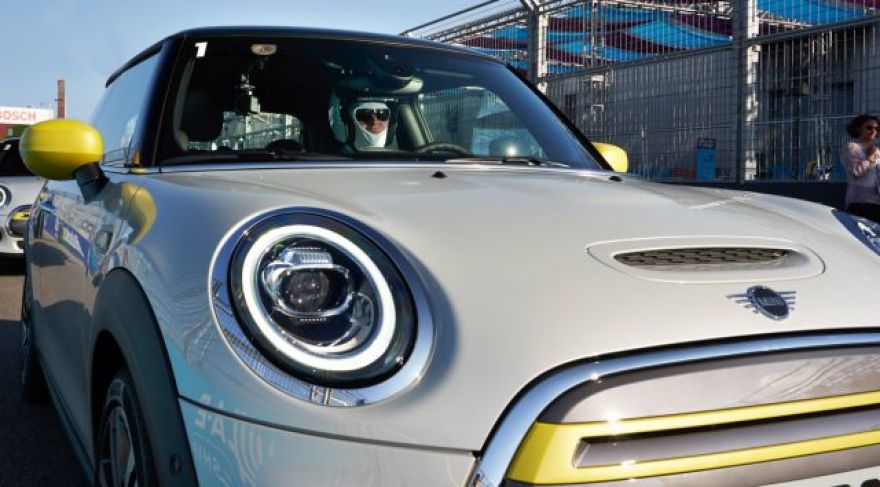
Hands On at the Track With the 2020 Mini Cooper SE Electric
Mini is targeting urban performance over exurban range with the 2020 Mini Cooper SE. And performance is exceptional. Battery life will be better suited for urban/suburban driving than vacation treks. Mini says the SE travels 235-270 km (146-168 miles) based on European testing. Some reports say EPA range will be as little as 114 miles per charge, while US pricing is likely to start around $35,000-$38,000 based on European pricing, although euro-to-dollar conversions can be simplistic.
Some of the tradeoffs stem from the car’s provenance: The three-door hatchback body is based on a Mini design that dates to 2014.
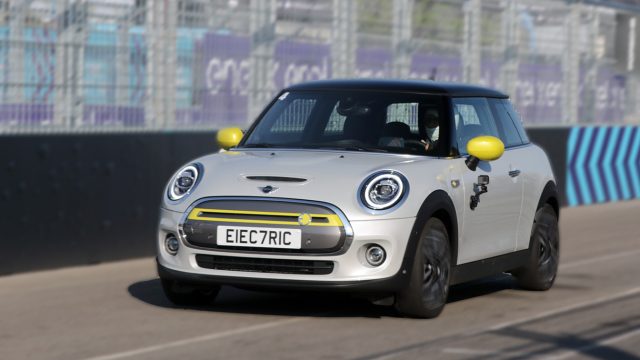
The Mini Cooper SE (Mini Electric outside the US) is cat-quick on Brooklyn’s tight 1.5-mile Formula E racetrack.
Crisp Handling, One-Pedal Driving at the Track
Mini used the occasion of the Formula E race in Brooklyn to invite a dozen auto writers and editors to sample the new car on the 1.5-mile track. (After the professionals were done racing for the day.) Flat-out driving wasn’t possible on the tight track. What was clear was how quick the car accelerated at the kinds of speeds you’d experience building up steam entering a highway on-ramp or getting through a stoplight that just turned yellow. There is very little lean even at the track’s 180-degree hairpin turn.
Most significantly, when you flip a button on the console for max regeneration, the resistance provided by the generator charging the battery effectively takes over the braking chores. Driving in a tightly bunched wave of five similar Minis, lifting off the throttle immediately slowed my car significantly for the next turn. I only needed to feather the brakes a couple of times on a 15-turn track, typically when the pre-collision alert indicator flashed in the head-up display. (The PCS warning provides ample advance notice.)
If you’ve ever been karting, this is the same one-pedal sensation: The moment you lift off the throttle, you’re effectively braking. If you haven’t karted, it’s like being aboard a riding mower when you lift. (If you haven’t been aboard a riding mower, well, it’s exciting for 15 minutes.) For drivers who find max regen unsettling, at least at first, you can flip the switch for more minimal brake regeneration.
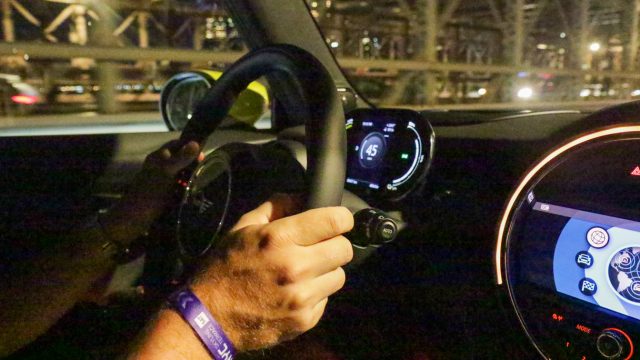
Crossing NYC bridges in the Cooper SE.
Night Rider, Too
To round out the sporty urban-car experience, Mini offered night drives during the race weekend. In this case, the cars were driven by company pros, because it was hard enough making it to the 6 PM lapping experience without a drink (the FIA race sponsoring body has a 0.0 percent BAC rule for anyone going on the track) and impossible to get to 10 PM without a cocktail or two.
In crowded Brooklyn and Manhattan, this was a perfect car for moving about at night, plenty quick, with zero tailpipe emissions. It’s a good car for two, although this two-door has seatbelts for five. At 152 inches long (12-plus feet) it’s easy to find openings in traffic and then at the curb.
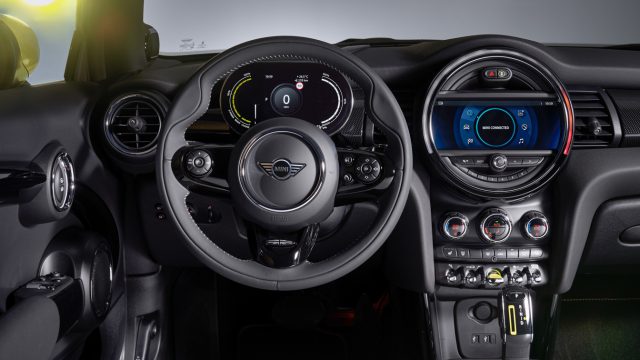
The instrument panel and center stack of the Mini Cooper SE.
Mini Cooper SE Specs
The Mini Cooper SE (US name) / Mini Electric (Europe name) is a front-motor, front-drive car. The 32.6-kWh lithium-ion battery forms a T that runs between the front seats and under the back seats. The electric motor is rated at 135 kW or 181 US hp, and 270 Nm (199 pound-feet) torque. It’s a transplant from the carbon-fiber BMW i3 city vehicle, or as Mini puts it, “[The] drive technology comes from the BMW Group competence centers for electro mobility in Dingolfing and Landshut [Germany].” Production is in Oxford, England.
The battery/motor combination is good for 7.3 second 0-100 kph runs (0-62 mph). It feels especially strong getting to 30 mph. The low position of the battery packs lowers the car’s center of gravity by 30 mm (1.2 inches). You’ll have to work to roll this Mini. It weighs in at 3,010 pounds (1,365 kg), 320 pounds (145 kg) more than the gas-engine Cooper S with an automatic gearbox. Top speed is 93 mph. Charging is possible from a 12-volt socket, a wall-mounted home charger, or public charging stations, including DC fast charging at 50 kW. At 50 kW, you get an 80 percent charge in 35 minutes.
Electronics include Apple CarPlay, a 5.5-inch multi-information display in the instrument panel, and a 6.5-inch LCD in a big circle at the top of the center stack.
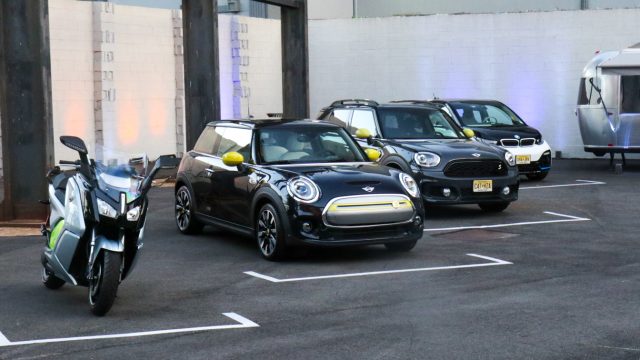
Mini Cooper SE (electric), gas-engine Mini Cooper S, and BMW i3. (Far left: BMW C Evolution electric scooter.)
How Successful Will a $35K Short-Ranger Be?
The car is half a year from shipping in the US. But judgments are being formed. Some of the early press/analyst reports say it’s a lot of money for a car that gets as little as 114 miles in the US. (AutoPacific analyst Ed Kim says it’s a good price/performance point for a 2015 EV.) US pricing is likely to be in the mid-thirties for a Mini. It’s a little better price/performance ratio at 140-150 miles (the European WLPT estimate). BMW execs said they didn’t want to burden the Mini Cooper SE with a higher price tag. Our $35,000-$39,000 USA starting-price estimate is a simple conversion of UK pricing, £27,900, or Europe pricing, €34,400. There will be three trim lines: Signature, Signature Plus, and Iconic.
At a weekend press conference at the Formula E race in Brooklyn, Pieter Nota, BMW board member for customer-brands-sales, got roughed up by the media who noted that a short-range EV is more of an urban than a suburban car, yet most urban areas, especially New York City, have precious few charging stations. (BMW and Mini have a relationship with the ChargePoint network.) And, said writers and editors who live in the Big Apple, when you go to a parking garage that claims to offer EV charging, it may be the wrong kind, it’s not working, or there are no free charging spaces. This is not a BMW-Mini problem, though.
The real BMW-Mini-specific problem is where Mini’s future lies: It’s primarily a sedan/coupe brand at a time when SUVs dominate. Electrification may boost Mini’s sales, which peaked at 66,502 in the US in 2013 and had led Mini to say they’d sell 100,000 vehicles a year in 2020. Instead, they fell to just 43,684 last year and may be as low as 36,000 this year, based on June year-to-date sales of less than 18,000. Mini’s woes may be one reason chairman Harald Krueger opted not to seek an extension of his contract that expires next year.
Our take is that the range — say it’s 140 miles — is a little disappointing relative to the price. But Mini needed to get an EV into the market. It had a prototype out in 2008 that was made available to 400 enthusiasts, and Mini had plenty of time to digest their comments. (One was that they didn’t like batteries replacing the back seat, which shows how far technology has come. Now the back seat is back.) It should have been out already. We’re assuming the Mini Cooper SE will live for 2-3 years and then we’ll see a much-improved version using newer BMW-Mini technology. BMW will ship the iX3 — a battery-electric X3 — in a year or so, reportedly with a 300-hp motor and battery good for 250 miles on a charge. The next electric Mini likely will use a scaled-down version of that motor.
Meantime, for the price of what the Mini Cooper SE likely costs, you can get a Tesla Model 3, Kira Niro EV, Chevrolet Bolt, or Nissan Leaf Plus with 226 to 258 miles or range. Only the Tesla matches Mini as a perceived premium brand, which may justify some of the pricing. Or for $30,000 you could get a 150-mile Nissan Leaf. Mini must be counting on the fun factor to woo buyers. That it is: fun, and fast.
Now read: